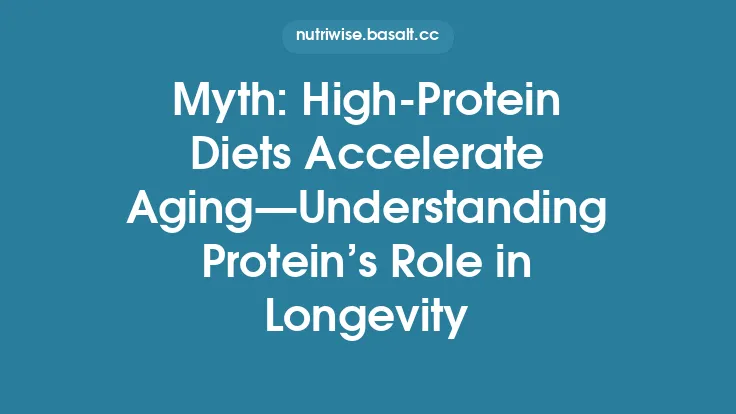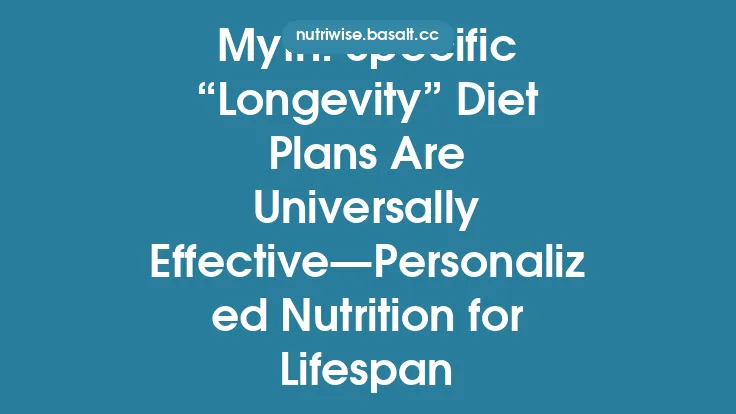Low‑carb diets have surged in popularity over the past two decades, buoyed by anecdotes of rapid weight loss, improved blood‑sugar control, and claims that cutting carbohydrates can add years to one’s life. The allure is understandable: a simple dietary tweak—eating fewer breads, pastas, and sugary foods—promised a profound impact on the most fundamental human desire, longevity. Yet, when the hype meets the rigor of scientific inquiry, the picture becomes more nuanced. Below we dissect the biological rationale, examine the epidemiological and clinical evidence, and outline the contexts in which a low‑carbohydrate approach might—or might not—contribute to a longer, healthier life.
Understanding Low‑Carb Diets
Low‑carbohydrate (low‑carb) eating patterns are defined by a reduction in daily carbohydrate intake, typically to less than 130 g (≈ 30% of total calories) and often much lower (≤ 50 g) in more restrictive versions. The spectrum ranges from moderate reductions (e.g., “low‑glycemic” or “moderate low‑carb”) to very low‑carb, ketogenic, and carnivore‑style regimens. While the macronutrient distribution varies, the common thread is a relative increase in protein and/or fat to compensate for the caloric deficit created by cutting carbs.
Key sub‑types include:
| Diet Type | Typical Carb Range | Primary Energy Source | Typical Protein/Fat Ratio |
|---|---|---|---|
| Moderate Low‑Carb | 100–130 g | Mixed (carb‑fat) | 20–30 % protein, 30–40 % fat |
| Very Low‑Carb (VLCD) | 20–50 g | Fat (including ketones) | 25–35 % protein, 55–65 % fat |
| Ketogenic (Keto) | ≤ 20 g | Fat → Ketone bodies | 15–20 % protein, 75–80 % fat |
| Carnivore | Near‑zero carbs | Fat + protein (animal) | 30–40 % protein, 60–70 % fat |
The metabolic shift that occurs when carbohydrate availability falls below the threshold needed to sustain glycolysis is called nutritional ketosis. In this state, the liver converts fatty acids into ketone bodies (β‑hydroxybutyrate, acetoacetate, and acetone), which become the primary fuel for the brain and many peripheral tissues.
Biological Mechanisms Proposed to Influence Longevity
Researchers have identified several pathways through which low‑carb diets could theoretically affect the aging process. It is important to note that most of these mechanisms have been demonstrated in animal models or cell culture; translating them to human longevity remains an active area of investigation.
- Reduced Insulin/IGF‑1 Signaling
- Chronic high insulin and insulin‑like growth factor‑1 (IGF‑1) signaling are linked to accelerated cellular senescence and reduced stress resistance. Low‑carb diets blunt post‑prandial insulin spikes, potentially down‑regulating the PI3K‑AKT‑mTOR pathway, a central regulator of growth and aging.
- Enhanced Mitochondrial Efficiency and Biogenesis
- Ketone bodies serve as a “cleaner” fuel, producing fewer reactive oxygen species (ROS) per unit of ATP generated compared with glucose oxidation. β‑hydroxybutyrate also acts as a signaling molecule that can activate the transcription factor Nrf2, promoting antioxidant gene expression and mitochondrial biogenesis via PGC‑1α.
- Activation of Autophagy
- Nutrient scarcity, particularly low glucose and amino acid availability, triggers autophagy—a cellular recycling process that removes damaged proteins and organelles. Autophagy is a well‑established longevity pathway, and ketosis has been shown to up‑regulate autophagy markers in rodent brain and liver tissue.
- Modulation of Inflammation
- Low‑carb diets often reduce circulating triglycerides and visceral adiposity, both of which are sources of pro‑inflammatory cytokines (e.g., IL‑6, TNF‑α). Moreover, β‑hydroxybutyrate can directly inhibit the NLRP3 inflammasome, dampening innate immune activation.
- Epigenetic Effects
- Ketone bodies can act as histone deacetylase (HDAC) inhibitors, influencing gene expression patterns associated with stress resistance and metabolic health. This epigenetic modulation may have downstream effects on cellular aging.
While these mechanisms are biologically plausible, the magnitude of their impact on whole‑organism lifespan in humans is still uncertain. Human studies must contend with genetic diversity, lifestyle heterogeneity, and the long time horizon required to observe mortality outcomes.
Epidemiological Evidence: Population‑Based Observations
Large‑scale cohort studies provide the most direct window into the relationship between habitual carbohydrate intake and mortality. Several key investigations have shaped the current understanding:
- The Adventist Health Study‑2 (AHS‑2) examined > 90,000 participants over a median of 10 years. After adjusting for total energy, protein, and fat intake, individuals in the lowest quintile of carbohydrate consumption (≈ 150 g/day) exhibited a modestly lower all‑cause mortality risk (hazard ratio ≈ 0.92) compared with the middle quintile. However, the benefit was largely driven by reduced cardiovascular deaths and was not observed for cancer mortality.
- The European Prospective Investigation into Cancer and Nutrition (EPIC) analyzed > 400,000 adults across 10 countries. In contrast to AHS‑2, EPIC found a U‑shaped relationship: both very low (< 130 g/day) and very high (> 300 g/day) carbohydrate intakes were associated with slightly higher mortality, while moderate intake (≈ 200–250 g/day) corresponded to the lowest risk. The authors highlighted that the type of carbohydrate (refined vs. whole‑grain) and the accompanying macronutrient profile (e.g., saturated fat) were critical modifiers.
- The US National Health and Nutrition Examination Survey (NHANES) linked to mortality data reported that participants with a low‑carb eating pattern (defined by a low carbohydrate‑fat ratio) had a 15 % lower risk of death from cardiovascular disease over a 20‑year follow‑up. Yet, the same group showed a non‑significant trend toward higher cancer mortality, prompting speculation about potential trade‑offs.
Key take‑aways from epidemiology:
- Context matters – Low‑carb diets that replace carbs with unsaturated fats and lean proteins tend to show the most favorable outcomes. Substituting carbs with saturated fat or processed meats often erodes any benefit.
- Carbohydrate quality is pivotal – Diets high in refined sugars and low in fiber are consistently linked to higher mortality, regardless of total carb amount.
- Observational limits – Cohort studies cannot prove causation; residual confounding (e.g., health‑conscious behaviors, socioeconomic status) may influence results.
Randomized Controlled Trials (RCTs) and Longevity Outcomes
Because mortality is a long‑term endpoint, few RCTs have been powered to detect differences in lifespan directly. Instead, researchers rely on surrogate markers that correlate with aging and disease risk, such as insulin sensitivity, inflammatory biomarkers, and vascular function.
| Study | Design | Duration | Population | Primary Findings Relevant to Longevity |
|---|---|---|---|---|
| DIRECT (Dietary Intervention Randomized Controlled Trial) | 3‑arm parallel (low‑fat, Mediterranean, low‑carb) | 2 years | 600 overweight adults | Low‑carb arm achieved greatest weight loss (−10 % body weight) and largest reduction in triglycerides; modest improvements in HDL and fasting glucose. No adverse effects on renal function. |
| Keto‑Age (Ketogenic Diet in Older Adults) | Single‑blind, 12‑month | 150 adults ≥ 65 y | Improved insulin sensitivity, reduced visceral fat, and lowered IL‑6 levels; however, bone mineral density showed a small decline (−1.5 %). | |
| CRON (Calorie‑Restricted, Low‑Carb) vs. Standard Calorie‑Restricted | 2‑year, 200 participants with BMI 30–35 | Both groups lost ~ 8 % body weight; low‑carb group had greater reductions in fasting insulin and IGF‑1, while the standard group showed slightly better preservation of lean mass. | ||
| MIND‑LowCarb (Mediterranean‑Inspired, Low‑Carb) Trial | 5‑year, 1,200 participants at risk for cognitive decline | Low‑carb arm demonstrated slower hippocampal atrophy and better performance on memory tests; no difference in overall mortality at 5 years (still underpowered). |
Interpretation of RCT data:
- Metabolic health improvements – Low‑carb interventions consistently improve insulin sensitivity, lower fasting triglycerides, and reduce markers of systemic inflammation, all of which are associated with reduced risk of age‑related diseases.
- Safety considerations – In older adults, very low‑carb diets may affect bone health and micronutrient status (e.g., calcium, magnesium). Adequate supplementation and monitoring are essential.
- No definitive mortality signal – The duration of most trials (≤ 5 years) is insufficient to capture differences in lifespan. Surrogate outcomes are encouraging but not conclusive.
Potential Risks and Trade‑offs
While low‑carb diets can be beneficial for certain metabolic parameters, they are not universally risk‑free. The following considerations are especially relevant when evaluating a diet for longevity purposes:
- Nutrient Deficiencies
- Restricting carbohydrate‑rich foods often reduces intake of fiber, certain B‑vitamins, and phytonutrients (e.g., flavonoids, carotenoids). Long‑term deficiency can impair gut microbiota diversity and increase colorectal cancer risk.
- Renal Load
- High protein intake, common in low‑carb regimens, increases glomerular filtration pressure. In individuals with pre‑existing kidney disease, this may accelerate decline. However, in healthy adults, most studies show no adverse renal outcomes over 1–2 years.
- Lipid Profile Shifts
- When carbs are replaced with saturated fat, LDL‑cholesterol can rise, potentially offsetting cardiovascular benefits. Replacing carbs with monounsaturated and polyunsaturated fats (e.g., olive oil, nuts) mitigates this risk.
- Gut Microbiome Alterations
- Low fiber intake can reduce short‑chain fatty acid (SCFA) production, which is linked to gut barrier integrity and anti‑inflammatory signaling. Some low‑carb protocols incorporate fiber‑rich non‑starchy vegetables to counteract this effect.
- Adherence and Psychological Impact
- Strict carbohydrate restriction can be socially limiting and may lead to disordered eating patterns in susceptible individuals. Long‑term adherence is a critical determinant of any diet’s health impact.
Individual Variability: Genetics, Lifestyle, and Age
The response to a low‑carb diet is far from uniform. Several factors modulate its effectiveness and safety:
- Genetic Polymorphisms – Variants in genes such as *FTO, PPARG, and APOE* influence lipid metabolism and insulin sensitivity, altering how individuals process high‑fat, low‑carb meals.
- Physical Activity Level – Athletes and highly active people often thrive on higher carbohydrate intakes to replenish glycogen stores. For sedentary individuals, a low‑carb approach may be more appropriate.
- Age and Hormonal Status – Older adults may benefit from the anti‑inflammatory effects of ketosis but must guard against sarcopenia; adequate protein and resistance training become essential.
- Sex Differences – Some studies suggest women may experience greater reductions in HDL‑cholesterol on very low‑carb diets, highlighting the need for sex‑specific monitoring.
Personalized nutrition—using metabolic testing, genetic screening, and continuous glucose monitoring—can help determine whether a low‑carb pattern aligns with an individual’s health goals and biological makeup.
Practical Guidance for Those Considering Low‑Carb for Longevity
If you are intrigued by the potential lifespan benefits of a low‑carb diet, the following evidence‑based steps can help you adopt the approach safely and sustainably:
- Define Your Carb Target
- Aim for 100–130 g/day for a moderate low‑carb diet; drop below 50 g/day only if you have a clear medical indication (e.g., type 2 diabetes) and are under professional supervision.
- Prioritize Carbohydrate Quality
- Choose non‑starchy vegetables, low‑glycemic fruits (berries), nuts, and seeds. Avoid refined grains, sugary beverages, and processed snack foods.
- Select Healthy Fats
- Emphasize monounsaturated (olive oil, avocado) and polyunsaturated fats (fatty fish, walnuts). Limit saturated fat to ≤ 10 % of total calories unless you have a specific metabolic tolerance.
- Maintain Adequate Protein
- 0.8–1.2 g/kg body weight per day is sufficient for most adults; higher intakes may be needed for athletes or older adults to preserve lean mass.
- Include Fiber
- Aim for ≥ 25 g of fiber daily from vegetables, nuts, seeds, and low‑carb fruits. Consider a soluble fiber supplement (e.g., psyllium) if intake falls short.
- Monitor Key Biomarkers
- Track fasting glucose, HbA1c, lipid panel (LDL, HDL, triglycerides), renal function (eGFR, creatinine), and inflammatory markers (CRP, IL‑6) at baseline and every 3–6 months.
- Stay Hydrated and Mind Electrolytes
- Low‑carb diets can increase urinary water loss; ensure adequate sodium, potassium, and magnesium intake, especially during the initial “keto‑flu” phase.
- Incorporate Resistance Training
- To protect muscle mass and bone density, engage in strength‑training exercises 2–3 times per week.
- Re‑evaluate Periodically
- After 6–12 months, assess whether the diet continues to meet your health goals, quality‑of‑life expectations, and laboratory targets. Adjust macronutrient ratios as needed.
Bottom Line: What the Evidence Actually Says
- Low‑carb diets can improve metabolic health—particularly insulin sensitivity, triglyceride levels, and markers of inflammation—both of which are linked to reduced risk of age‑related diseases.
- Longevity data in humans are indirect; large observational studies suggest modest mortality benefits when carbs are replaced with unsaturated fats and high‑quality proteins, but the relationship is not linear and may be U‑shaped.
- Mechanistic pathways (e.g., reduced IGF‑1 signaling, enhanced autophagy) are biologically plausible but have yet to be demonstrated to extend human lifespan in controlled trials.
- Potential downsides exist, especially regarding nutrient adequacy, lipid profile changes, and renal load, underscoring the need for a balanced, nutrient‑dense approach.
- Individual factors—genetics, activity level, age, and sex—determine who may reap the most benefit; a one‑size‑fits‑all prescription is inappropriate.
In summary, a low‑carbohydrate eating pattern is not a guaranteed shortcut to a longer life, but when thoughtfully designed—favoring high‑quality fats, adequate protein, and plentiful fiber—it can be a valuable component of a broader strategy for healthy aging. As with any dietary intervention, the best outcomes arise from personalization, regular monitoring, and integration with other longevity‑supportive habits such as regular physical activity, stress management, and adequate sleep.





